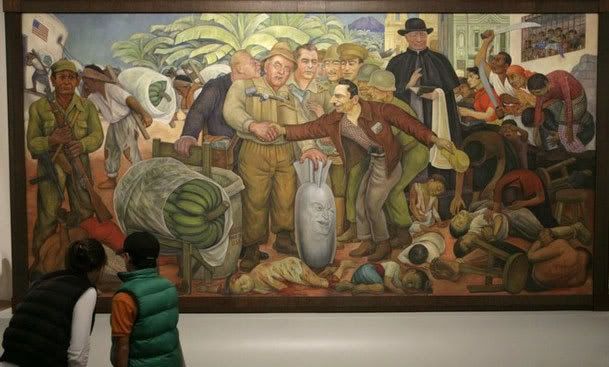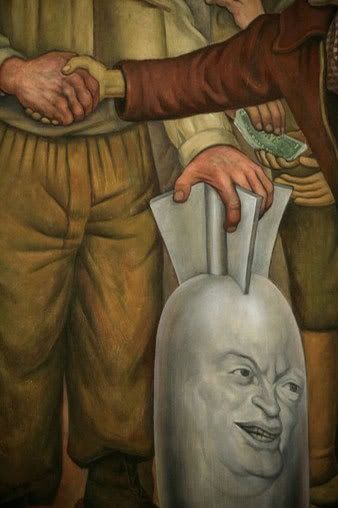Welcome to DU!
The truly grassroots left-of-center political community where regular people, not algorithms, drive the discussions and set the standards.
Join the community:
Create a free account
Support DU (and get rid of ads!):
Become a Star Member
Latest Breaking News
General Discussion
The DU Lounge
All Forums
Issue Forums
Culture Forums
Alliance Forums
Region Forums
Support Forums
Help & Search
General Discussion
Related: Editorials & Other Articles, Issue Forums, Alliance Forums, Region ForumsRigoberta Menchu Vindicated
http://www.thenation.com/blog/195593/rigoberta-menchu-vindicatedThis week, a Guatemalan court vindicated Rigoberta Menchú. Menchú, as many will remember, was a poor, Mayan peasant woman who lost nearly her whole family to US-backed Guatemalan security forces, only to find herself conscripted into the US culture wars by pundits and academics, who, having picked apart her best-selling memoir, I, Rigoberta Menchú, charged her with exaggerating her hardships.
Among the family members family members Menchú lost was her father, Vicente Menchú, who died on January 31, 1980, in the Spanish Embassy in Guatemala City, after he and scores of other Mayan peasants occupied the building to bring attention to escalating repression in the countryside. In response, Guatemala’s National Police fire-bombed the embassy, killing nearly forty people, including protesters and embassy staff. One survivor, Gregorio Yuja Xona, was dragged from his hospital bed, tortured, his corpse tossed out on the street.
Now, just short of the thirty-fifth anniversary of the massacre, the International Justice Monitor reports that three very courageous judges
convicted Pedro Garcia Arredondo, former head of “Command 6,” a special investigations unit of the now-defunct National Police, of homicide and crimes against humanity for his leadership of the 1980 siege of the Spanish embassy, which killed dozens of indigenous and student activists and diplomats. This notorious event during the Guatemalan internal armed conflict ruptured Guatemala’s relationship with Spain for years and preceded an intensifying conflict and further atrocities committed against indigenous communities and human rights activists. Thirty-five years after the events, this is the first time the case was heard before a court.
The court also found Arredondo guilty of the attempted murder of protester Gregorio Yuja Xona and former Spanish ambassador Maximo Cajal, the only survivors of the fire. (Xona was later tortured and executed.) The three-judge panel further found Arredondo guilty of the murder of two students during a mass funeral organized to honor the victims of the siege.
A crowd of indigenous victims gathered early outside of the courthouse to perform a Mayan ritual and to hear this historic verdict.
It’s an important verdict, and not only because it is a rare conviction in a country still largely ruled by impunity. The 1980 firebombing was one of the events Menchú’s fact-checkers used to discredit her account of Guatemala’s long civil war, which over the course of more than three decades claimed 200,000 victims. Menchú’s accuser, an anthropologist, argued that the embassy protesters killed themselves in an act of “revolutionary suicide that included murdering hostages and fellow protesters” in order to make the government look bad. It was a ludicrous charge, largely based on showing a few grainy photographs of the bomb scene to arson analysts. But it did its damage: it raised doubts about what many considered the signal event in Guatemala’s bloody civil war, a brute display of unyielding power when many Guatemalans, after realizing that no reform would be tolerated, threw in with a fast-growing insurgency. Blaming this massacre on the protesters was meant to undercut accounts that focused on “structural violence,” racism and economic exploitation for the ensuing genocide, when the army slaughtered around 100,000 people, mostly Mayan peasants, over the course of about two years (1981–83). Calling the killing a suicide also had the effect of transforming Menchú’s father from victim to victimizer, from someone invested with the moral stature of Martin Luther King into a crazed suicidal jihadi.
Among the family members family members Menchú lost was her father, Vicente Menchú, who died on January 31, 1980, in the Spanish Embassy in Guatemala City, after he and scores of other Mayan peasants occupied the building to bring attention to escalating repression in the countryside. In response, Guatemala’s National Police fire-bombed the embassy, killing nearly forty people, including protesters and embassy staff. One survivor, Gregorio Yuja Xona, was dragged from his hospital bed, tortured, his corpse tossed out on the street.
Now, just short of the thirty-fifth anniversary of the massacre, the International Justice Monitor reports that three very courageous judges
convicted Pedro Garcia Arredondo, former head of “Command 6,” a special investigations unit of the now-defunct National Police, of homicide and crimes against humanity for his leadership of the 1980 siege of the Spanish embassy, which killed dozens of indigenous and student activists and diplomats. This notorious event during the Guatemalan internal armed conflict ruptured Guatemala’s relationship with Spain for years and preceded an intensifying conflict and further atrocities committed against indigenous communities and human rights activists. Thirty-five years after the events, this is the first time the case was heard before a court.
The court also found Arredondo guilty of the attempted murder of protester Gregorio Yuja Xona and former Spanish ambassador Maximo Cajal, the only survivors of the fire. (Xona was later tortured and executed.) The three-judge panel further found Arredondo guilty of the murder of two students during a mass funeral organized to honor the victims of the siege.
A crowd of indigenous victims gathered early outside of the courthouse to perform a Mayan ritual and to hear this historic verdict.
It’s an important verdict, and not only because it is a rare conviction in a country still largely ruled by impunity. The 1980 firebombing was one of the events Menchú’s fact-checkers used to discredit her account of Guatemala’s long civil war, which over the course of more than three decades claimed 200,000 victims. Menchú’s accuser, an anthropologist, argued that the embassy protesters killed themselves in an act of “revolutionary suicide that included murdering hostages and fellow protesters” in order to make the government look bad. It was a ludicrous charge, largely based on showing a few grainy photographs of the bomb scene to arson analysts. But it did its damage: it raised doubts about what many considered the signal event in Guatemala’s bloody civil war, a brute display of unyielding power when many Guatemalans, after realizing that no reform would be tolerated, threw in with a fast-growing insurgency. Blaming this massacre on the protesters was meant to undercut accounts that focused on “structural violence,” racism and economic exploitation for the ensuing genocide, when the army slaughtered around 100,000 people, mostly Mayan peasants, over the course of about two years (1981–83). Calling the killing a suicide also had the effect of transforming Menchú’s father from victim to victimizer, from someone invested with the moral stature of Martin Luther King into a crazed suicidal jihadi.
Rigoberta Menchu is now owed an apology by all who tried to discredit her. She won't get it (because those who did that were either implacable hardline Cold Warriors who felt that the so-called cause of "fighting communism" justified ANY means, or were simply propagandists on the payroll of the Guatemalan military regime) but she does have it coming.
The just woman has prevailed.
InfoView thread info, including edit history
TrashPut this thread in your Trash Can (My DU » Trash Can)
BookmarkAdd this thread to your Bookmarks (My DU » Bookmarks)
6 replies, 1313 views
ShareGet links to this post and/or share on social media
AlertAlert this post for a rule violation
PowersThere are no powers you can use on this post
EditCannot edit other people's posts
ReplyReply to this post
EditCannot edit other people's posts
Rec (15)
ReplyReply to this post
6 replies
 = new reply since forum marked as read
Highlight:
NoneDon't highlight anything
5 newestHighlight 5 most recent replies
= new reply since forum marked as read
Highlight:
NoneDon't highlight anything
5 newestHighlight 5 most recent replies
Rigoberta Menchu Vindicated (Original Post)
Ken Burch
Jan 2015
OP
delrem
(9,688 posts)1. Wow. Thanks, Ken.
I so, so much appreciate the good news.
ucrdem
(15,512 posts)2. K'N'R
ReRe
(10,597 posts)3. FYI...
...l Amy Goodman, http://www.DemocracyNow.org
with the help of an interpreter, interviewed her.
Ken Burch
(50,254 posts)4. cool. thanks.
uh, did you just say that YOU are Amy Goodman? Or did I read that wrong?
ReRe
(10,597 posts)5. Definitely NOT Amy
I thought it was on yesterday's show, but I tried to find it. Hope I didn't dream that I seen it. ![]() I was half awake at the time. It's there, somewhere. May have been Tuesday.
I was half awake at the time. It's there, somewhere. May have been Tuesday.
Octafish
(55,745 posts)6. John Foster Dulles and Allen Dulles enjoyed the work of Diego Rivera.

Diego Rivera: Glorious Victory!
Mark Vallens
Art for Change
Friday, October 05, 2007
EXCERPT…
Painted in 1954, the mockingly titled Glorious Victory has as its subject the infamous CIA coup of the same year that overthrew Guatemala’s democratically elected government. At the center of the mural, CIA Director John Foster Dulles can be seen shaking hands with the leader of the coup d'état, Colonel Castillo Armas. Sitting at their feet is an anthropomorphized bomb bearing the smiling face of U.S. President Dwight D. Eisenhower - who gave orders to launch the military coup. In the background, a priest can be seen officiating over the massacre of workers, many of which can be seen lying slaughtered in the painting’s foreground.

The head of the Central Intelligence Agency at the time of the coup, Allen Dulles, and the U.S. Ambassador to Guatemala during the coup, John Peurify, are depicted handing out money to various Guatemalan military commanders and fascist junta officials, as Mexican Indian workers slave away at loading bananas onto a United Fruit Company ship. I might add that Allen Dulles was on the board of directors of the United Fruit Company when the U.S. overthrew the government of Guatemala.
CONTINUED…
http://art-for-a-change.com/blog/2007/10/diego-rivera-glorious-victory.html